FORD FIESTA 2007 Repair Manual
Manufacturer: FORD, Model Year: 2007, Model line: FIESTA, Model: FORD FIESTA 2007Pages: 1226, PDF Size: 61.26 MB
Page 51 of 1226
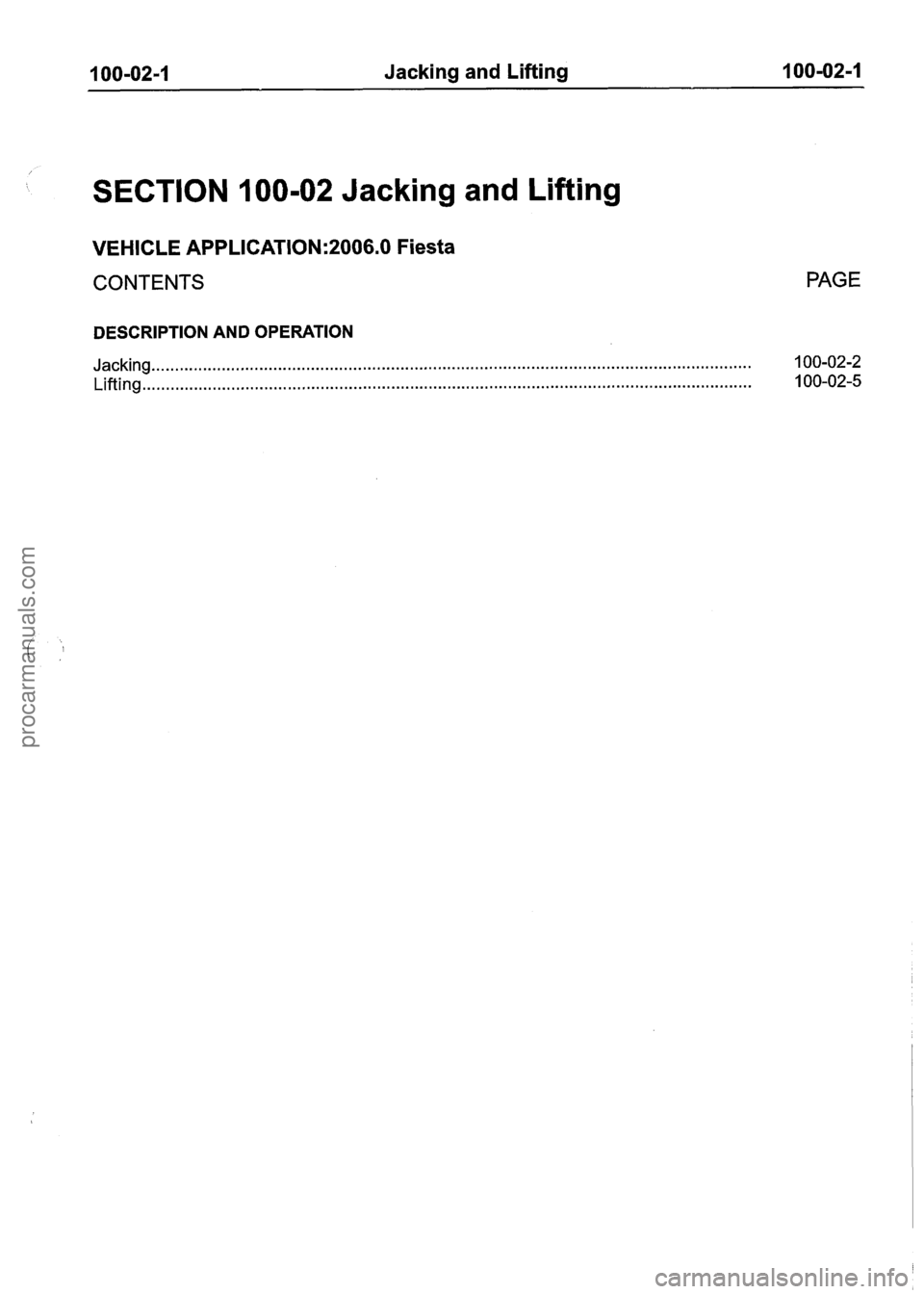
100-02-1 Jacking and Lifting 100-02-1
SECTION 100-02 Jacking and Lifting
VEHICLE APPLICATION:2006.0 Fiesta
CONTENTS PAGE
DESCRIPTION AND OPERATION
Jacking.. ........................................................................\
...................................................... 1 00-02-2
Lifting
........................................................................\
.......................................................... 1 00-02-5
procarmanuals.com
Page 52 of 1226

100-02-2 Jacking and Lifting 100-02-2
DESCRIPTION AND OPERATION
Jacking
A WARN1NG:Only the specified jacking
points may be used for jacking up and
supporting the vehicle.
A CAUTI0N:Park the vehicle on a flat, level
and stable surface. If the vehicle must be
lifted on a soft surface, the supporting forces
must be spread by using a suitable(:
base under the jack. Place a wheel chock
against the wheel opposite the jack. Failure
to follow these instructions may result in
personal injury.
In order to prevent damage to the rocker panel
moulding (if equipped), the covers must be
removed at the relevant locations in the rocker
panel moulding before raising the vehicle.
2006.0 Fiesta 1212006 GI 67070en
procarmanuals.com
Page 53 of 1226
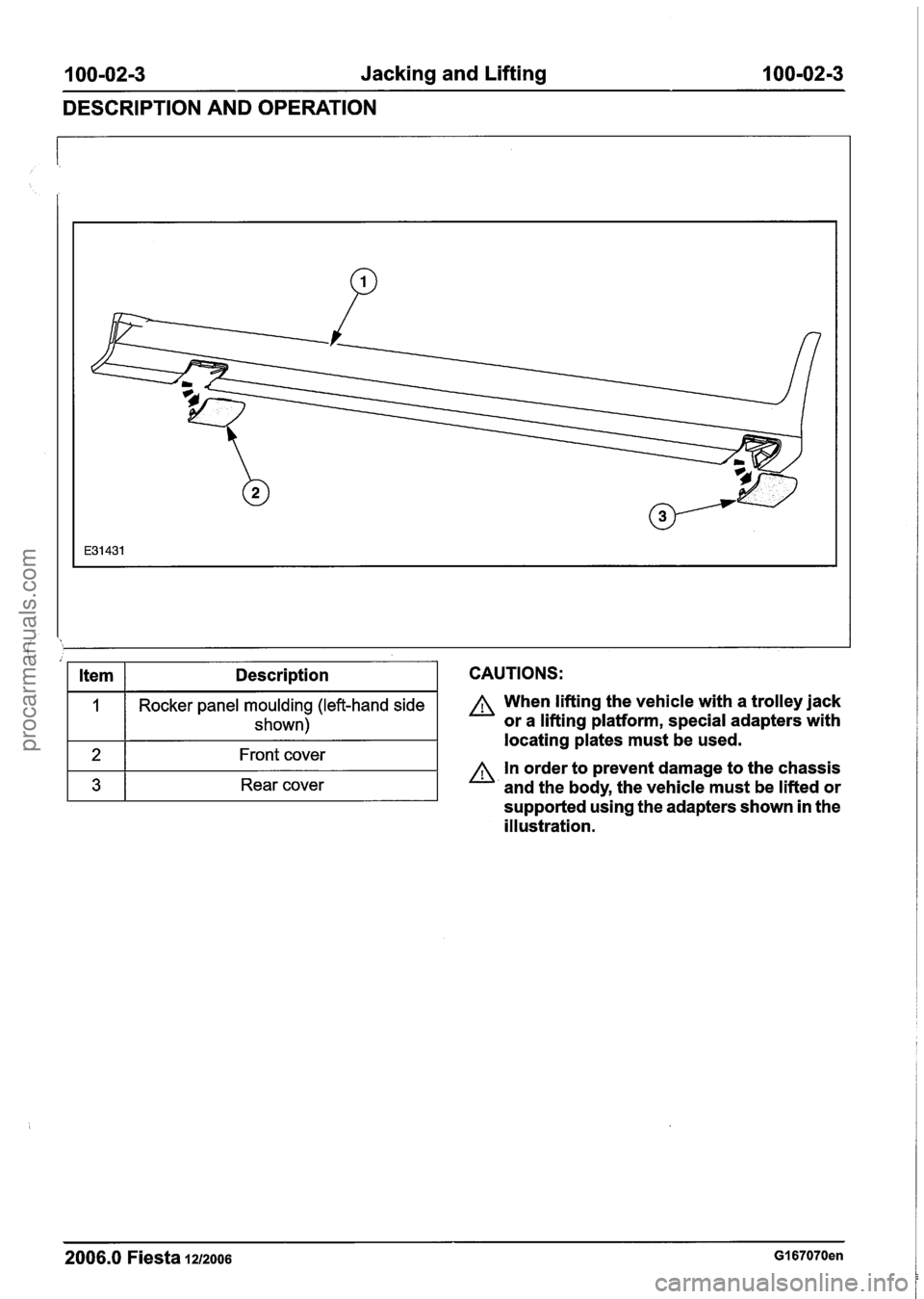
100-02-3 Jacking and Lifting 100-02-3
DESCRIPTION AND OPERATION
CAUTIONS: Item
1
2
3
A When lifting the vehicle with a trolley jack
or a lifting platform, special adapters with locating plates must be used.
Description
Rocker panel moulding (left-hand side shown)
Front cover
Rear cover
A In order to prevent damage to the chassis
and the body, the vehicle must be lifted or
supported using the adapters shown in the
illustration.
2006.0 Fiesta 1212006 GI 67070en
procarmanuals.com
Page 54 of 1226
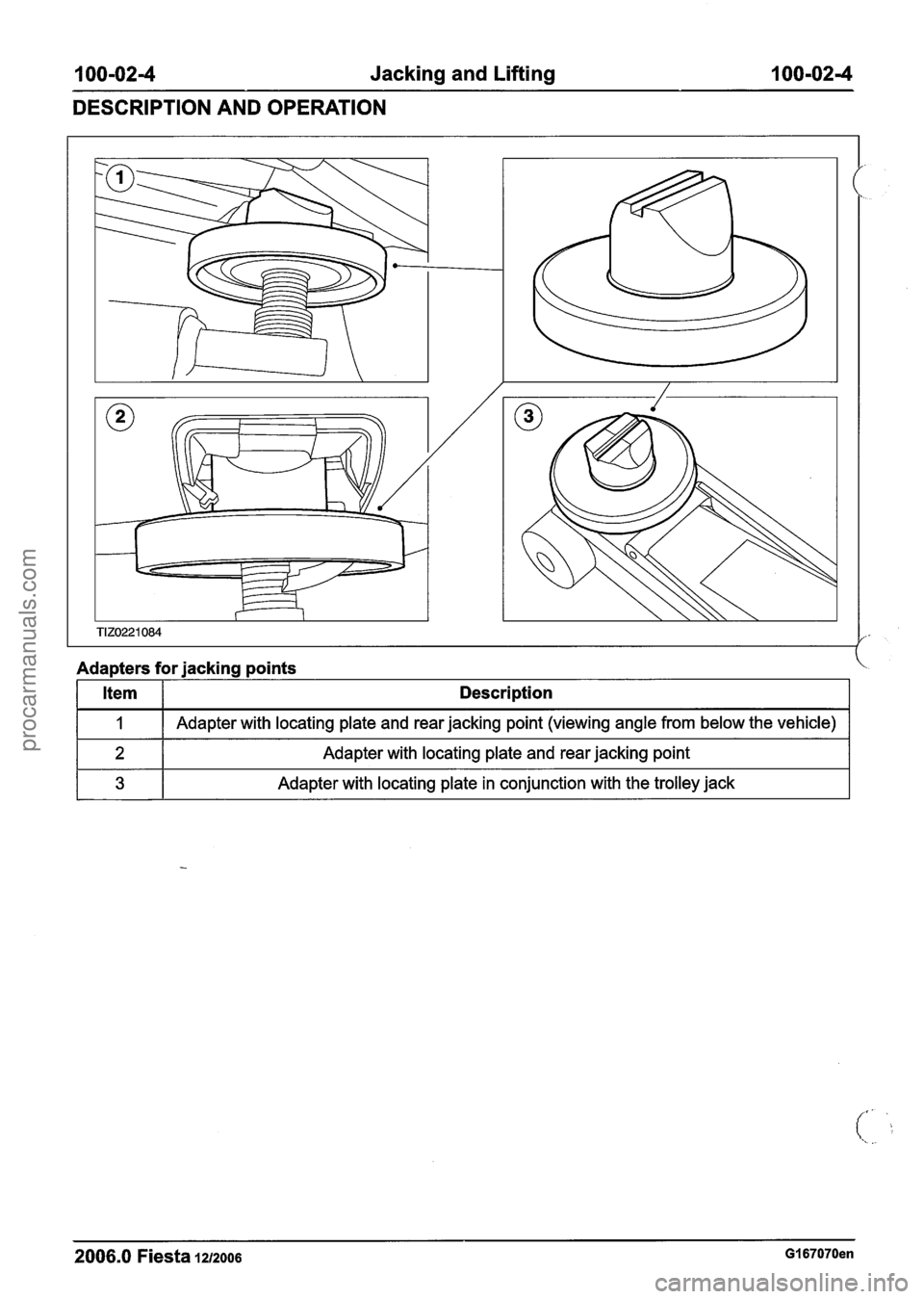
100-024 Jacking and Lifting 100-02-4
DESCRIPTION AND OPERATION
Adapters for jacking points
2006.0 Fiesta 1212006 GI 67070en
Item
I
2
3
Description
Adapter with locating plate and rear jacking point (viewing angle from below the vehicle)
Adapter with locating plate and rear jacking point
Adapter with locating plate in conjunction with the trolley jack
procarmanuals.com
Page 55 of 1226

100-02-5 Jacking and Lifting 100-02-5
DESCRIPTION AND OPERATION
Lifting
/' A WARNING:Only raise the vehicle at the A CAUTI0N:Place blocks underneath the
specified lifting points. hoist points
if a two-column hoist is used.
- -- --
2006.0 Fiesta 1212006 GI 67072en
procarmanuals.com
Page 56 of 1226
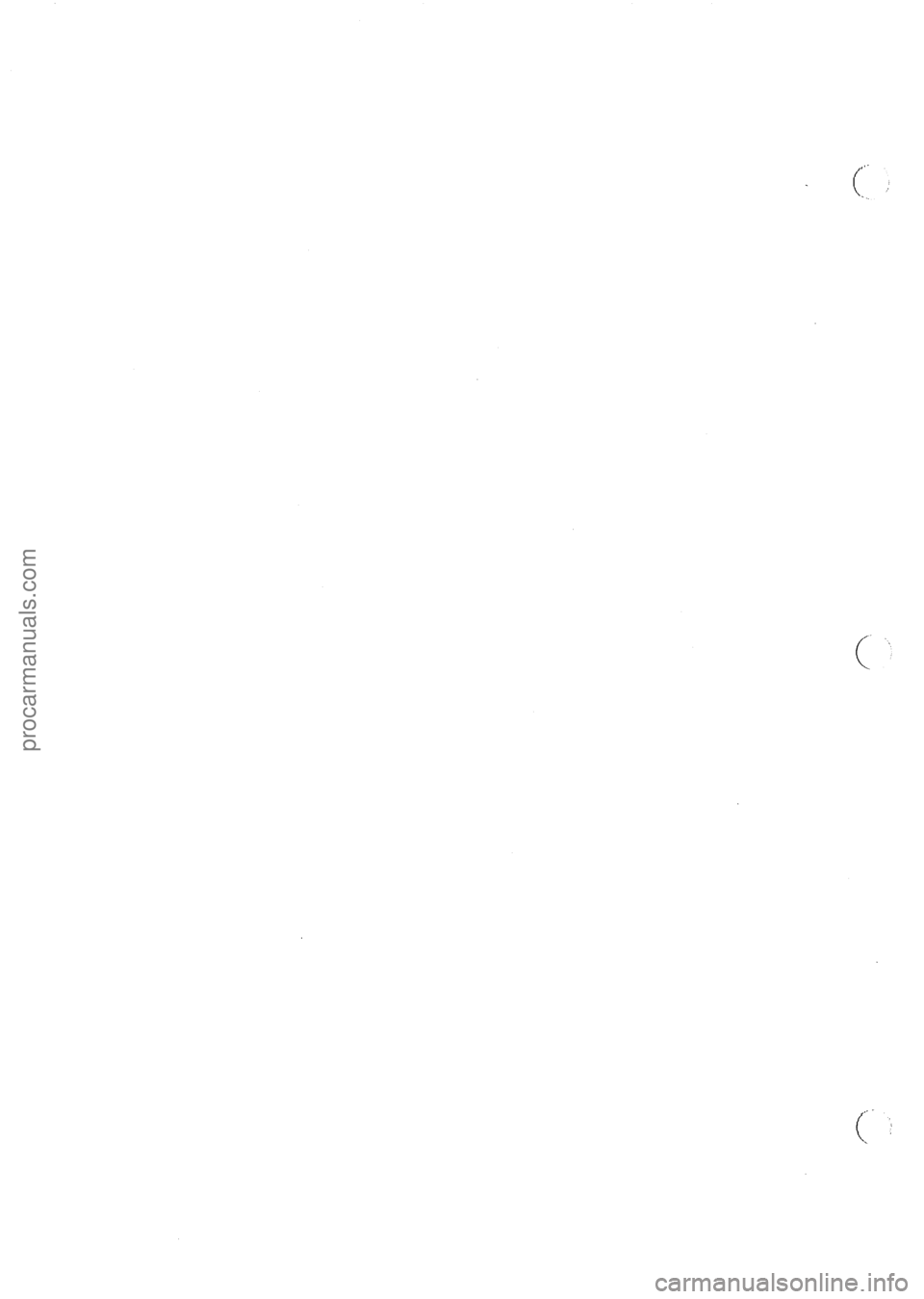
procarmanuals.com
Page 57 of 1226
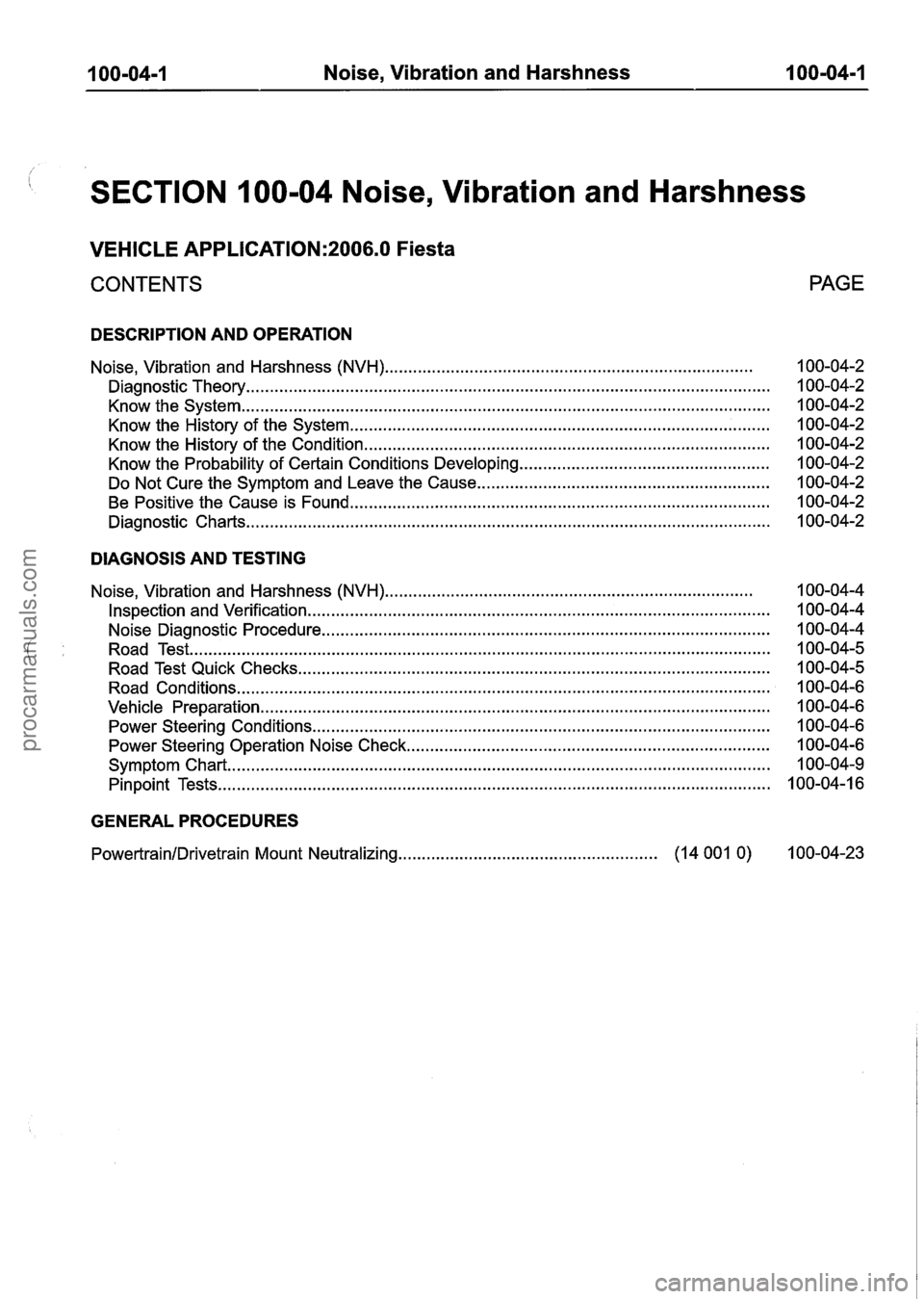
100-04-1 Noise. Vibration and Harshness 100-04-1
SECTION 100-04 Noise. Vibration and Harshness
VEHICLE APPLICATION:2006.0 Fiesta
CONTENTS PAGE
DESCRIPTION AND
OPERATION
Noise. Vibration and Harshness (NVH) ........................................................................\
...... 1 00-04-2
........................................................................\
....................................... Diagnostic Theory 1 00-04-2
........................................................................\
........................................ Know the System 1 00-04-2
........................................................................\
................. Know the History of the System 100-04-2
Know the History of the Condition
........................................................................\
.............. 100-04-2
Know the Probability of Certain Conditions Developing
..................................................... 100-04-2
Do Not Cure the Symptom and Leave the Cause
............................................................ 100-04-2
Be Positive the Cause is Found
........................................................................\
................. 100-04-2
........................................................................\
....................................... Diagnostic Charts 1 00-04-2
DIAGNOSIS AND TESTING
Noise. Vibration and Harshness (NVH) ........................................................................\
...... 1 00-04-4
........................................................................\
.......................... Inspection and Verification 100-04-4
........................................................................\
....................... Noise Diagnostic Procedure 1 00-04-4
........................................................................\
................................................... Road Test 100-04-5
........................................................................\
............................ Road Test Quick Checks 100-04-5
Road Conditions
........................................................................\
......................................... 100-04-6
........................................................................\
.................................... Vehicle Preparation 1 00-04-6
........................................................................\
......................... Power Steering Conditions 100-04-6
........................................................................\
..... Power Steering Operation Noise Check 100-04-6
........................................................................\
........................................... Symptom Chart 1 00-04-9
Pinpoint Tests
........................................................................\
............................................. 100-04-1 6
GENERAL PROCEDURES
PowertrainlDrivetrain Mount Neutralizing ................................................. (1 4 001 0) 100-04-23
procarmanuals.com
Page 58 of 1226
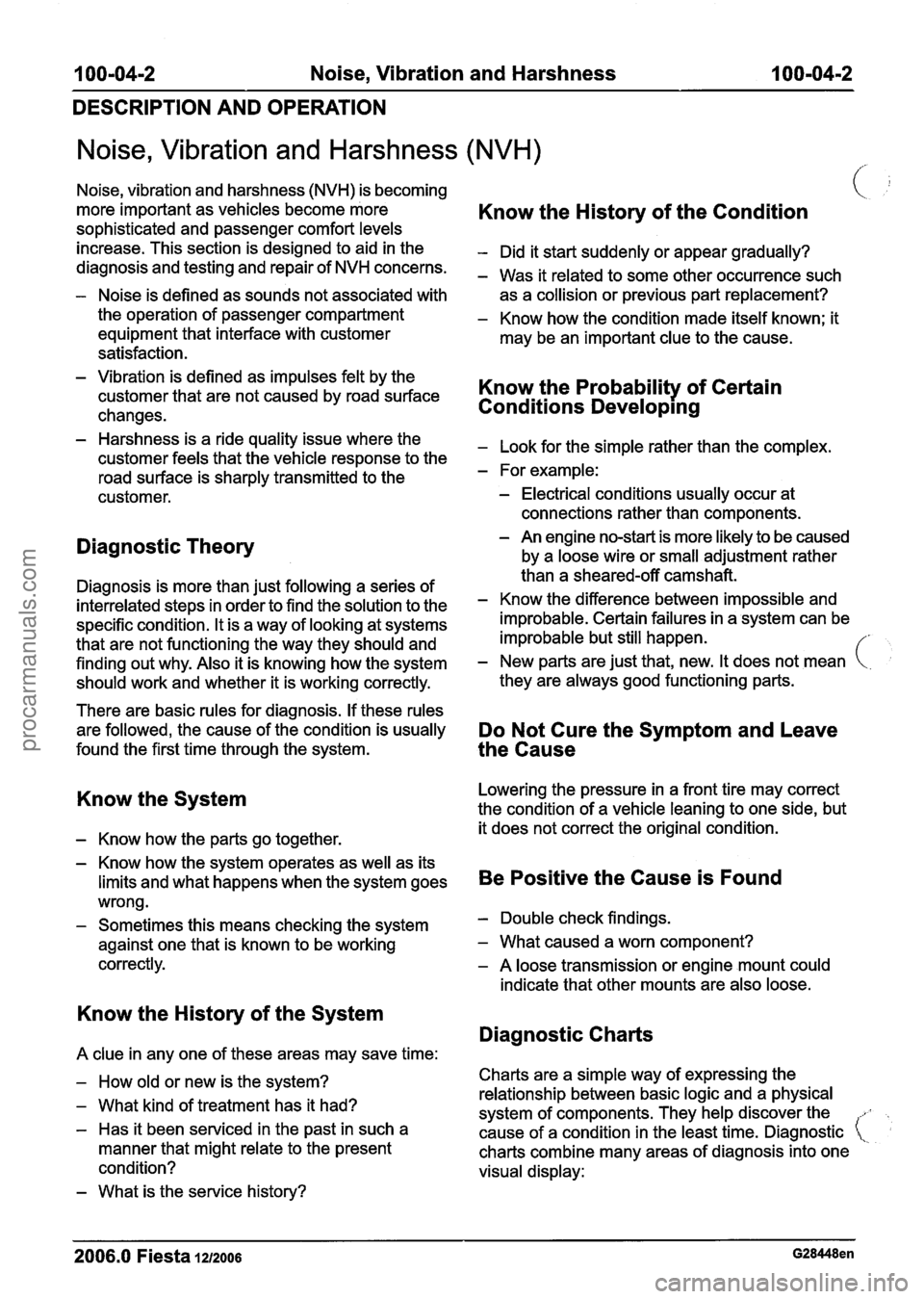
100-04-2 Noise, Vibration and Harshness 100-04-2
DESCRIPTION AND OPERATION
Noise, Vibration and Harshness (NVH)
Noise, vibration and harshness (NVH) is becoming
more important as vehicles become more '
Know the History of the Condition
sophisticated and passenger comfort levels
increase. This section is designed to aid in the
- Did it start suddenly or appear gradually?
diagnosis and testing and repair of NVH concerns.
- Was it related to some other occurrence such
- Noise is defined as sounds not associated with
as a collision or previous part replacement?
the operation of passenger compartment
- Know how the condition made itself known; it
equipment that interface with customer
may be an important clue to the cause.
satisfaction.
- Vibration is defined as impulses felt by the
customer that are not caused by road surface Know the Probability of Certain
changes. Conditions Develop~ng
- Harshness is a ride quality issue where the - Look for the simple rather than the complex.
customer feels that the vehicle response to the
road surface is sharply transmitted to the
- For example:
customer.
- Electrical conditions usually occur at
connections rather than components.
Diagnostic Theory - An engine no-start is more likely to be caused
by a loose wire or small adjustment rather
than a sheared-off
camshafi. Diagnosis is more than just following a series of
interrelated steps in order to find the solution to the - Know the difference between impossible and
specific condition. It is a way of looking at systems improbable. Certain failures
in a system can be
that are not functioning the way they should and improbable
but still happen.
finding out why. Also it is knowing how the system
- New parts are just that, new. It does not mean
should work and whether it is working correctly. they are always
good functioning parts.
There are basic rules for diagnosis. If these rules
are followed, the cause of the condition is usually
Do Not Cure the Symptom and Leave
found the first time through the system. the Cause
Know the System
- Know how the parts go together. Lowering
the pressure in a front tire may correct
the condition of a vehicle leaning to one side, but
it does not correct the original condition.
- Know how the system operates as well as its
limits and what happens when the system goes
Be Positive the Cause is Found
wrong.
- Sometimes this means checking the system - Double check findings.
against one that is known to be working
- What caused a worn component?
correctly.
- A loose transmission or engine mount could
indicate that other mounts are also loose.
Know the History of the System
Diagnostic Charts
A clue in any one of these areas may save time:
- How old or new is the system? Charts are a simple
way of expressing the
relationship between basic logic and a physical
- What kind of treatment has it had?
system of components. They help discover the ,.
- Has it been serviced in the past in such a
cause of a condition in the least time. Diagnostic (,-
manner that might relate to the present
charts combine many areas of diagnosis into one
condition? visual display:
- What is the service history?
2006.0 Fiesta 12/2006 G28448en
procarmanuals.com
Page 59 of 1226
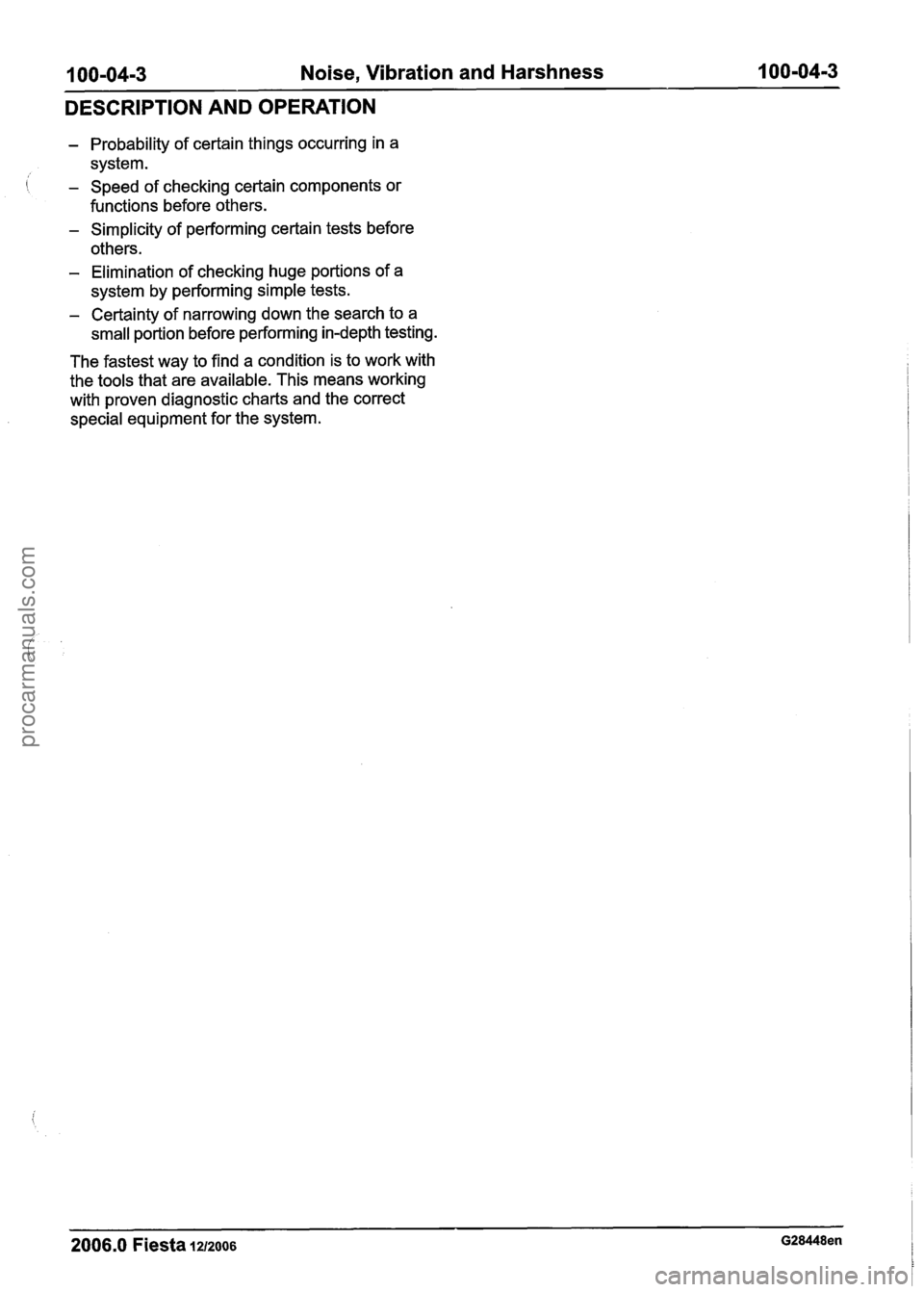
100-04-3 Noise, Vibration and Harshness 100-04-3
DESCRIPTION AND OPERATION
- Probability of certain things occurring in a
system.
1 - Speed of checking certain components or
functions before others.
- Simplicity of performing certain tests before
others.
- Elimination of checking huge portions of a
system by performing simple tests.
- Certainty of narrowing down the search to a
small portion before performing in-depth testing.
The fastest way to find a condition is to work with
the tools that are available. This means working
with proven diagnostic charts and the correct
special equipment for the system.
2006.0 Fiesta 1212006 G28448en
procarmanuals.com
Page 60 of 1226
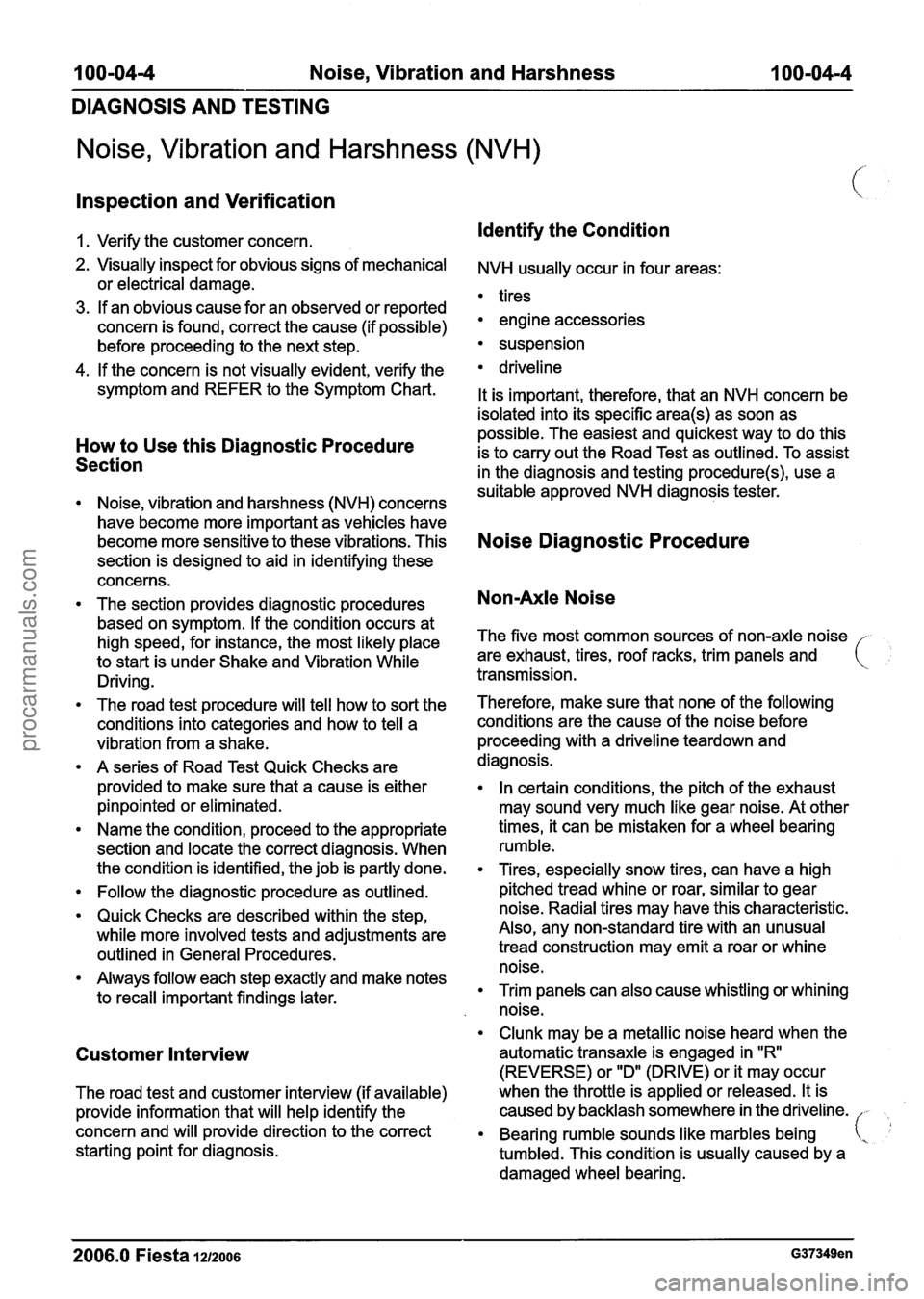
100-04-4 Noise, Vibration and Harshness 100-0414
DIAGNOSIS AND TESTING
Noise, Vibration and Harshness (NVH)
Inspection and Verification
1. Verify the customer concern. Identify the Condition
2. Visually inspect for obvious signs of mechanical NVH usually occur in four areas:
or electrical damage.
tires
3. If an obvious cause for an observed or reported
concern is found, correct the cause (if possible) engine accessories
before proceeding to the next step.
suspension
4. If the concern is not visually evident, verify the
symptom and REFER to the Symptom Chart.
How to Use this Diagnostic Procedure
Section
Noise, vibration and harshness (NVH) concerns
have become more important as
vehjcles have
become more sensitive to these vibrations. This
section is designed to aid in identifying these
concerns.
The section provides diagnostic procedures based on symptom. If the condition occurs at
high speed, for instance, the most likely place
to start is under Shake and Vibration While
Driving.
The road test procedure will tell how to sort the
conditions into categories and how to tell a
vibration from a shake.
A series of Road Test Quick Checks are
provided to make sure that a cause is either
pinpointed or eliminated.
Name the condition, proceed to the appropriate
section and locate the correct diagnosis. When
the condition is identified, the job is partly done.
Follow the diagnostic procedure as outlined.
Quick Checks are described within the step,
while more involved tests and adjustments are
outlined in General Procedures.
Always follow each step exactly and make notes
to recall important findings later.
driveline
It is important, therefore, that an NVH concern be
isolated into its specific
area(s) as soon as
possible. The easiest and quickest way to do this
is to carry out the Road Test as outlined. To assist
in the diagnosis and testing
procedure(s), use a
suitable approved NVH diagnosis tester.
Noise Diagnostic Procedure
Non-Axle Noise
The five most common sources of non-axle noise
are exhaust, tires, roof racks, trim panels and
( transmission.
Therefore, make sure that none of the following
conditions are the cause of the noise before
proceeding with a driveline
teardown and
diagnosis.
In certain conditions, the pitch of the exhaust
may sound very much like gear noise. At other
times, it can be mistaken for a wheel bearing
rumble.
Tires, especially snow tires, can have a high
pitched tread whine or roar, similar to gear
noise. Radial tires may have this characteristic.
Also, any non-standard tire with an unusual
tread construction may emit a roar or whine
noise.
Trim panels can also cause whistling or whining
noise.
Clunk may be a metallic noise heard when the
Customer Interview automatic transaxle is engaged in "R
(REVERSE) or "D" (DRIVE) or it may occur
The road test and customer interview (if available) when
the throttle is applied or released. It is
provide information that will help identify the caused
by backlash somewhere in the driveline.
,
concern and will provide direction to the correct Bearing rumble sounds like marbles being
starting point for diagnosis. (
tumbled. This condition is usually caused by a
damaged wheel bearing.
2006.0 Fiesta 1212006 G37349en
procarmanuals.com